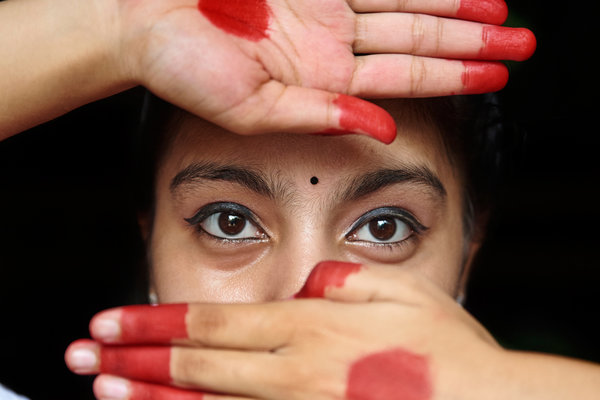As I sat in the colorist’s chair in a high-end salon, I could not help but admire how young I looked. My gray roots had just been obliterated with a $300 Chernobyl of Deep Chocolate Mocha and Buttery Caramel lowlights.
But I knew my hair high would be, as usual, a short-lived buzz. Within days, my mane would oxidize into Roadkill Orange, alluring as a badger pelt. And a telltale gray stripe would appear on my part, demarcating fact from fiction.
That skunky striation was always a surprising betrayal. Just when I’d tricked myself into believing that maybe I really was a 60-something sprouting a Starbucks palette of richly hued locks, the emergence of Witchy White, Grim Reaper Gray and Silver Scythe sadistically reminded me that the house always wins.
My pilgrimage to the salon was a well-worn ritual I practiced like a double-process parishioner for over 25 years. The welcoming, intoxicating mix of ammonia and gossip, coupled with required reading of trashy tabloid hymnals, made it, if not a religious experience, certainly close.
Where else could I go for salvation, maintaining my professional mien and reading up on Jennifer Aniston and Justin Theroux? I was getting older by the minute and dying my hair was one way to temporarily make the ever-encroaching reality of the final blowout disappear.
Until I met Tyler.
Tyler was a newly hired, fresh-faced television producer who would now be assigning and editing my stories in the newsroom where I had worked for almost 30 years. His smarts were undoubtedly fueled by kombucha or some green juice swill, I thought defensively, as I crouched in my cubicle.
I could report to a Bob, an Ed, a Phil, a Larry or a Linda — the default monikers of my generation. But a Tyler?!
The bell was not only tolling, it was booming, blaring, thunderously clapping.
Old enough to be Tyler’s mom, I asked myself: Who exactly was my outrageously expensive brown helmet fooling?
Tyler, and all the Conors, Kayleighs and Madisons lately populating my office didn’t give a toss if Mommy’s hair was brown, gray or green. And if my colleagues didn’t care, maybe I shouldn’t either.
And so I canceled my next hair appointment.
Which is not to say I made the decision lightly.
Would going gray require me to listen to folk music, host potlucks featuring casseroles of tempeh and wear fibrous, hand-woven caftans, accented with chunky, hand-forged jewelry?
Or could it be it a ticket to another way of being a woman in the world?
[Want more coverage of women and gender issues? Sign up for Gender Letter, a weekly newsletter, or follow us on Instagram.]
I started to notice chicly shorn women of a certain age with silver strands who looked gorgeous.
More than that, they seemed fierce and even proud. Gray hair appeared to confer erect posture, a purposeful stride and an unshakable sense of self. Was this true or was I wildly projecting?
Here’s what I found out:
As in every other stage in a women’s life, there’s a barrage of unsolicited advice as constant and contradictory as those Glamour magazine “Dos and Don’ts” of my teen years, in which some hapless girl, just trying to get from Algebra 2 to French 3, is splayed across the back page with the offending run in her stocking, there for the nation to judge.
So I shouldn’t have been surprised when my Tawny Sunset Blonde and Hazelnut Brûlée Brunette friends weighed in.
“You’ll be invisible and look like Grandma!”
“Mark will dump you for a younger woman!”
“You’ll torpedo your career!”
Social media also turned up the tyranny with admonitions and warnings.
“Don’t attempt to grow out gray yourself — you must consult with your stylist!”
“Gray hair drains color from your face! You need a bold new lipstick!”
“Limit your wardrobe to black and white — never ivory!”
“Gray hair is wiry, coarse, and brassy, adding years to your look! Keep it sleek with Keratin, blow drying, ironing! Be vigilant!”
Gray Instagram influencers — now called “Instagrannies” — relentlessly proselytized about being their best gray selves, living their best gray lives, relishing every gray moment, practicing gray self-care and doing so with a stylist, photographer and nutritionist on standby.
Rarely could I find Instagram accounts of ordinary gray-haired women who spent downtime pondering their pores in a magnifying mirror or standing in front of an open fridge, eating a pickle, a carton of leftover fried rice and a spoonful of peanut butter, calling it lunch.
Even before deciding to go gray, I had already been feeling a slight but unmistakable shift inside. As I hauled around my snail shell of a life inscribed with layers of sediment and time, older women, like the 80-year-old I once watched gingerly push her walker into the salon for a touch-up, elicited a startling recognition about where I was on the timeline. Edicts about how to look or how to behave, regardless of hair color, were losing their resonance.
So I ignored all the advice and just let my gray hair grow.
I was fascinated by the glittery tresses my body produced. How they caught the light and shimmered. I detected not 1 percentage drop of interest from my husband (the aforementioned Mark). There were no inferior work assignments or loss of love or friendship.
Shockingly, I just felt pretty.
As for that unshakable sense of self: As Jennifer Aniston herself might tell you, some days you’re up, some days Justin’s just moved on.
A highly unscientific statistic I just made up shows that 83 percent of women over age 60 who go gray do not regret it. Turns out they are more preoccupied with making the most of their remaining, brief visit to this planet than with all the hoopla surrounding hair color.
My gray hair is a gift from Mother Nature, who unknowingly thought a long life should be celebrated with a silver crown.
Once I quit the bottle, I didn’t look back.
But I miss the magazines.
Suzanne Bergerac Roth, a former television news writer in New York, writes essays and fiction.
Rites of Passage is a project of Styles and The Times Gender Initiative. For information on how to submit an essay, click here.










